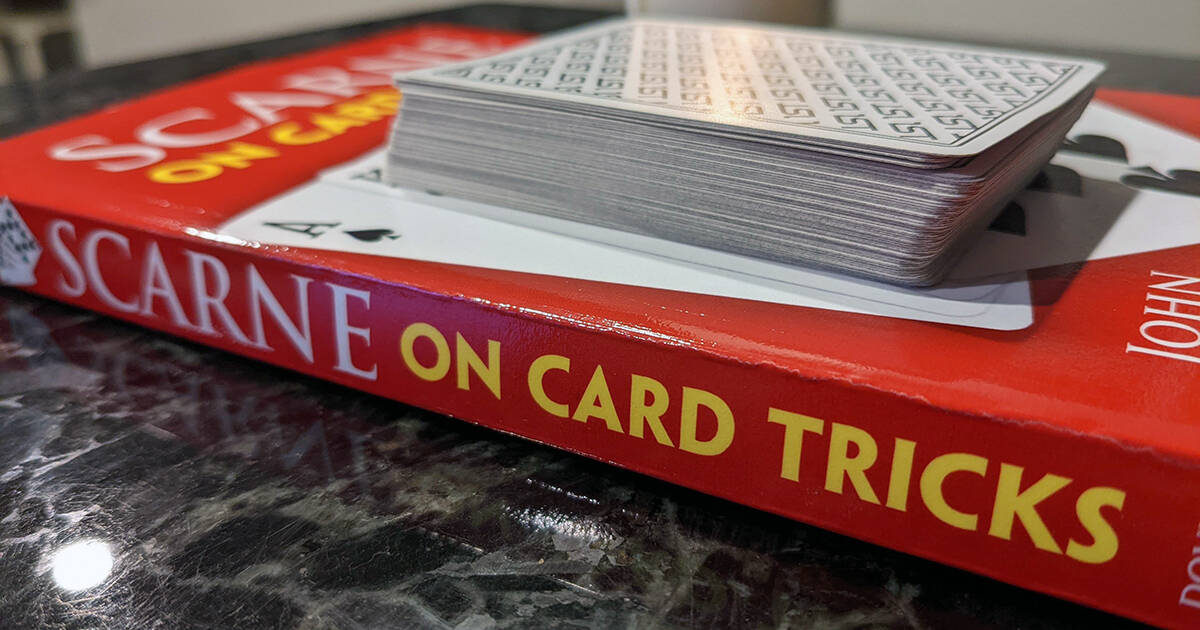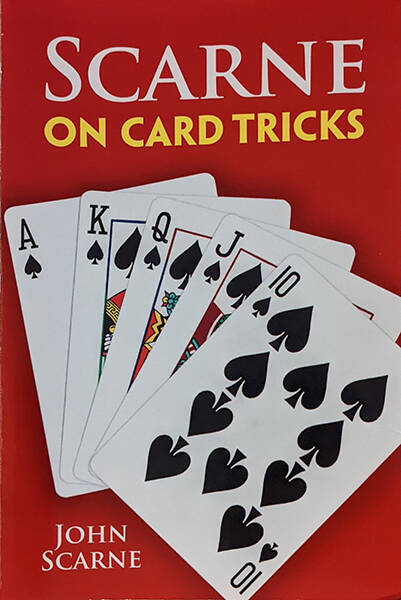

Last week I was away on vacation and I had planned to bring two books with me: The FFFF Book and Scarne on Card Tricks. At the very last minute, literally, I decided to leave The FFFF Book at home. I wanted to be able to actually read and enjoy the books I took with me and after a little more consideration, there just wouldn't have been time for both.
To set the stage, regarding Scarne on Card Tricks, I bought it maybe 2 years ago. And I opened it once. Not to read, but to skim the contents to look for tricks meeting a specific topic. Spoiler alert: I didn't find the trick I was looking for. This book, and the only thing I knew about it, was that it was by John Scarne and is referenced in more than a few places. It's also been reprinted more than once! To me, this meant that this book was full of treasure and is one that a lot of magicians look to.
Fast forward to last week when I finally sat down with it and started reading it. At the top of the Table of Contents is this quote:
The details and descriptions of all the tricks in this book were written by John Scarne. Many of the tricks are Scarne's own creations. Where a performer is listed here, it indicates that he was the originator of the trick, performs it frequently, helped to improve it or avows that the trick is a favorite of his.
"Whoa! This is great!" I thought. Scarne created a lot of the tricks in the book, and skimming the list of performers showed that there's material here from the greats like Al Baker, Bob Hummer, Cardini, Harry Lorayne, Dai Vernon, and so many more. Excited, I was. And then, I read the introduction (A New Era in Card Tricks).
Rather than supply the entire chapter of text here, a quick summary is all that is needed. Scarne created 30 some-odd effects, and the rest were works from other magicians. All of the tricks, he either created or modified to not require any sleight of hand.
To repeat, and clarify, the book Scarne on Card Tricks is a book that's full of 155 card tricks and not a single one requires sleight of hand.
My excitement level dropped immediately, upon reading this. Later, ironically, I found out that the very first sentence on the back cover of the book said the same thing.
Look, I'm all for self-working tricks. I actually use a few; some I created, most I adopted. But coming into this book, I expected sleights and something new and novel. Seeing, after working myself up for quite some time, that there was in fact none of that changed my mood towards the book and really soured how I was consuming it. That said, I did consume it.
Reading the Book
As with all magic books that I read, I started at the beginning and started reading to the end. This book doesn't follow a chronological order and tricks don't build off one another, but that doesn't change the reading pattern so front-to-back is how I went.
The first maybe 5 or 6 tricks, ugh. I was so upset because they were basic, they were self working or math based. My negative view of the book was just being piled on more and more. And then, I came to a trick that I said "Oh hey, that one's not a terrible idea. It might be something I could use on Instagram, but not in person."
The trick after that one, I said the same thing. Then the following trick I thought about how I could change it to work in person. The one after that gave me a topic to write about on this blog at a future date, though I wouldn't perform the trick. On and on I went through the book and the further I went, the more I found tricks that were really solid, sleights or not.
Effect Types
The card tricks presented throughout this book range in types. By that, I mean, the way they're performed.
Some of the tricks require a deck setup. If it's setup, you only need to follow a given storyline and boom, trick's done.
Other tricks are math based. They might also require a setup, or they might require you to get the card into a specific position. Similarly, some are spelling tricks that necessitate the same thing. Pre-knowledge of a certain number or name may also be required. I, personally, don't like math based tricks or spelling tricks so I only skimmed these descriptions. This is highly ironic given my math background =P
Other tricks require forces or peeks, maybe even diversions to be able to slip a card into your pocket. It's interesting, but I think Scarne kind of skewed the definition of what "sleight of hand" is for some of the routines because there are a couple that definitely use it. And I'm cool with that =]
Takeaways
I didn't mean for this to be a review of the book, though the more I sit here the more I realize it can be. The above can be read as a rant, as a description, as me just rambling on because I was too rash to buy a book without looking it up first, or however you want really. But here, in this takeaways section, let me just summarize how I really feel.
If I had done even the slightest amount of research on the book, or read the back cover, I would have known it was a sleight-less book on card magic. I would have still purchased it, and I would have still read it. It's my belief that knowing, whether using or not, but knowing the different types of routines is important to being a well-rounded and more advanced magician. This includes routines that involve sleights, and those that are otherwise self-working.
The amount of content in this book is amazing. It's a small book, but it has more material in it than books twice its size. It's not necessarily organized from easy to hard, but the majority of effects in the book do fit into that paradigm. There aren't any dividing lines though, so it would be worth the initial effort of skimming all of the Effects and noting the ones that are of interest. Knowing that there aren't any sleights would actually make this easier because you won't have to worry about "oh, do I need to be good with a Classic Pass or Faro Shuffle?!"
What's really great about the effects in the book is that they're easy to adapt and modify. A lot are really good as-is, but thinking of it from another perspective of changing things to fit your own style, they mesh quite well. And, it's easy to replace certain pieces with sleights if you were so intrigued.
The one thing I dislike about a number of the routines in the book is the card selection process. To me, a spectator selecting a card should be a simple and straightforward process. As Dani DaOrtiz says, the trick starts after the card is selected. In Scarne on Card Tricks, a lot of the tricks are the spectator selecting the card -- it's how the setup is created, and how it's able to be done without any sleights. Again, this could be circumvented by adding in a simple sleight, but I don't want to read a book with the thought that I'm reading a template and need to modify it; I'd like to know that I'm reading a trick I might actually use as-is and can modify if I wanted to.
So, yeah. I started the book really excited, and then I loathed it for a solid day. And by the time I finished the book, I loved it. I can see why so many folks like the book, and I am really glad I didn't leave it on the bus out of anger!
